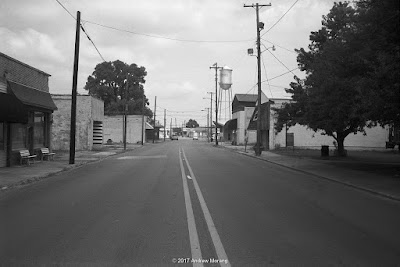Dear Readers, let us return to the Mother Road, the famous Route 66. When it was originally mapped out in the mid-1920s, Route 66 entered Santa Fe from the south after leaving Albuquerque. It then headed east and southeast through the mountains. But in 1937, Route 66 was rerouted to bypass Santa Fe (political posturing - who would have guessed?). Today, a traveler today can choose to travel on the older original 1920s routing or just drive east-west through Albuquerque. Regardless, Santa Fe, the capital of New Mexico, is one of the oldest cities in the Unites States and is ripe with interesting architecture, the arts, a famous opera, and cultural activities. The Georgia O'keefe Museum is amazing. My pictures below are a semi-random view of town. The standard tourist sites have been photographed millions (billions?) of times; I don't need to repeat them.
 |
| New Mexico Museum of Art, West Palace Ave. |
 |
| Maria's Kitchen, West Cordova Ave. |
Coming from parts of the country with predominantly wood architecture, I found the adobe architecture of New Mexico to be very interesting. It is ideally suited to the hot summers because the thick clay walls keep the blazing sun at bay.
 |
| Spanish festival, Sanat Fe Plaza |
There is no end to cultural activities and fun. The Santa Fe Plaza has been the social, commercial, and political center of the city since about 1610 (remember, this is one of of the oldest cities in the United States, only matched by St. Augustine in Florida). The Plaza is a National Historic Landmark.
 |
| Glass fruit at the famous 109 East Palace Ave. |
Just off the Plaza is a block of 1600s adobe buildings. One of these was the security and clearing office for the Los Alamos scientists and engineers during the early phase of the Manhattan project in World War II. Newly-arrived workers entered a perfectly ordinary-looking door and met the formidable Ms. McKibbin, who issued their passes. Then they exited out the rear to a bus, which took them up into the mountains to the new Los Alamos facility. From the
Atomic Heritage Foundation:
After arriving in Lamy, the scientists, SEDers, and families were directed to 109 E. Palace Avenue in Santa Fe. The building, constructed as a Spanish hacienda in the 1600s, is located just off the plaza in downtown Santa Fe. During World War II, it was the administrative hub of the Manhattan Project.
Dorothy Scarritt McKibbin was the first reassuring face the fatigued newcomers saw. At 109 East Palace, McKibbin informed them that their journey continued another 35 miles along the winding road up to the Pajarito Plateau. In the early months, she dispatched an average of 65 people each day to “the Hill,” as Los Alamos was called. The steady stream of arrivals meant the office was often “bedlam,” as McKibbin described it. She issued passes and IDs and directed newcomers to their homes, received shipments of household items to be distributed to the Hill’s residents, and tended to personal matters as needed. McKibbin was the perfect person for her job and quickly became indispensable as the “Gatekeeper” at 109 E. Palace Avenue and a close friend and confidante of Oppenheimer. She had a warm smile, an engaging personality and was reassuringly calm and efficient. In recognition of her contribution, McKibbin was awarded the title of “First Lady” of Los Alamos and declared a Living Treasure of Santa Fe.
Today, 109 E. Palace houses gift shops and sells glass fruit and other artsy items.
A family friend generously let us stay in his guest cottage. He has interesting items in his yard, along with resident bunnies.
 |
| Aspen Vista trail, approx. 10,600 ft altitude, Nexus 4 frame reprocessed with DxO FilmPack 5. |
Buy a hiking guidebook and try some of the trails around Santa Fe. Many are less than a hour from town.
 |
| Valles Calders National Preserve, Olympus Trip 35 exposure on Kodak BW400CN film. |
Head north into the mountains to the Valles Caldera National Preserve (established by president Clinton, part of the National Park Service). The high altitude air is clear and crisp. View this ancient supervolcano and watch elk grazing in the pastures. Listen to the silence (except when some Harleys come thundering along).
The composer, Igor Stravinsky, conducted regularly at the Santa Fe Opera from 1957 to 1962. This bust is on the Stravinsky Terrace of The Santa Fe Opera. The opera, on a stunning site north of town, is a fabulous venue for top-class opera. Make a point to attend a performance!
Santa Fe and the surrounding mountains are a fantastic vacation destination, highly recommended!
The square photographs are from Tri-X 400 film in a Hasselblad camera. The rectangle frames are Kodak BW400 film from a Yashica Electro 35CC camera (a convenient travel camera with a top-quality 35mm f/1.8 Color-Yashinon lens). The view of Valles Caldera was taken with a Olympus Trip 35 camera with a polarizer to emphasize the clouds. You can click any frame to see the larger photograph.

































